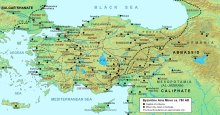Armeniac Theme
| Theme of the Armeniacs Άρμενιακόν, θέμα Άρμενιάκων, Άρμενιακόν θέμα | |
|---|---|
| Theme of the Byzantine Empire | |
| 640s/660s–ca. 1073 | |
 The Byzantine themes of Asia Minor in circa 780, after the split of the Opsikion. | |
| Capital | Amaseia |
| Historical era | Middle Ages |
• Established | 640s/660s |
| ca. 1073 | |
| Today part of | |
The Armeniac Theme (Greek: Άρμενιακόν [θέμα], Armeniakon [thema]), more properly the Theme of the Armeniacs (Greek: θέμα Άρμενιάκων, thema Armeniakōn) was a Byzantine theme (a military-civilian province) located in northeastern Asia Minor (modern Turkey).
History
The Armeniac Theme was one of the four original themes, established sometime in the mid-7th century out of the territory of Lesser Armenia (also known as "Armenia Minor"). Although the mention of a "George, tourmarchēs of the Armeniacs" in 629, during the Persian campaigns of Emperor Heraclius (r. 610–641),[1] may suggest the existence of the theme at such an early date, the first unambiguous reference to it in literary sources occurs during the revolt of its general, Saborios, in 667/668.[2] It is next mentioned on a seal of 717/718.[3] Together with the other themes, it was created from the remnants of one of the field armies of the old East Roman army following the disastrous defeats suffered during the first wave of the Muslim conquests, a process probably complete by the late 640s.[4] Thus, the army of the magister militum per Armeniae (the "Armeniacs") was withdrawn and settled in the areas of Pontus, Paphlagonia and Cappadocia, giving its name to the region.[5]

The theme's capital was at Amaseia, and it was governed by a stratēgos, who ranked, together with the stratēgoi of the Anatolic and Thracesian themes, in the first tier of stratēgoi, drawing an annual salary of 40 gold pounds.[2] In the 9th century, it fielded some 9,000 men and encompassed 17 fortresses. Its size and strategic importance on the Byzantine Empire's north-eastern frontier with the Muslims made its governor a powerful figure, and the theme's forces participated in several revolts in the 8th century.[2] Consequently, in the 9th century it was broken up: the smaller provinces of Charsianon and Cappadocia were formed, first as kleisourai and later as full themes, along the border in the south and east, while in circa 819, the coastal themes of Paphlagonia and Chaldia were split off, followed later by the area of Koloneia (first under a doux, by 863 under a full strategos), leaving a rump Armeniac theme encompassing the western Pontus.[6]
The theme remained in Byzantine hands until the late 11th century. In 1073, however, following the disastrous Battle of Manzikert, Frankish mercenaries under Roussel de Bailleul seized control and governed the region for several months, until Byzantine authority was restored by general Alexios Komnenos.[7] Shortly after, the region was overrun by the Seljuk Turks, with only a few coastal forts holding out. The Komnenian emperors managed to recover the coastal regions for the Empire, but the Armeniac theme was not restored.
References
- ^ Haldon 1999, p. 315.
- ^ a b c Kazhdan 1991, p. 177.
- ^ Ragia 2009, p. 217: "The inscriptions on the seals of the warehouses in the beginning of the 8th c. took the following forms: "the warehouse of Koloneia and Kamacha" (702-704), "of Koloneia, Kamacha and Armenia IV" (713-715), which finally became "of Koloneia and all the provinces of the Christ-loving Armeniakon" (717/8)." [Ragia, in footnote #78, is citing McGeer, Nesbitt & Oikonomides 2001, No. 65.1, 74.4, 22.27.]
- ^ Haldon 1997, pp. 214–216.
- ^ Haldon 1999, pp. 73, 112.
- ^ Kazhdan 1991, pp. 177, 1138, 1579; Treadgold 1995, p. 31.
- ^ Haldon 1999, pp. 91–92, 269.
Sources
- Gyftopoulou, Sofia (May 20, 2003). Αρμενιάκων Θέμα. Encyclopedia of the Hellenic World: Asia Minor (in Greek). Foundation of the Hellenic World. Retrieved 7 October 2009.
{{cite web}}: Invalid|ref=harv(help) - Haldon, John F. (1997). Byzantium in the Seventh Century: The Transformation of a Culture. Cambridge, United Kingdom: Cambridge University Press. ISBN 978-0-521-31917-1.
{{cite book}}: Invalid|ref=harv(help) - Haldon, John F. (1999). Warfare, State and Society in the Byzantine World, 565-1204. London, United Kingdom: University College London Press (Taylor & Francis Group). ISBN 1-85728-495-X.
{{cite book}}: Invalid|ref=harv(help) - Kazhdan, Alexander Petrovich, ed. (1991). The Oxford Dictionary of Byzantium. New York, New York and Oxford, United Kingdom: Oxford University Press. ISBN 978-0-19-504652-6.
{{cite book}}: Invalid|ref=harv(help) - McGeer, Eric; Nesbitt, John W.; Oikonomides, Nicolas, eds. (2001). Catalogue of Byzantine Seals at Dumbarton Oaks and in the Fogg Museum of Art, Volume 4: The East. Washington, District of Columbia: Dumbarton Oaks Research Library and Collection. ISBN 0-88402-282-X.
{{cite book}}: Invalid|ref=harv(help) - Pertusi, A. (1952). Constantino Porfirogenito: De Thematibus (in Italian). Rome, Italy: Biblioteca Apostolica Vaticana.
{{cite book}}: Invalid|ref=harv(help) - Ragia, Efi (2009). "The Geography of the Provincial Administration of the Byzantine Empire (ca 600-1200): I.1. The Apothekai of Asia Minor (7th-8th c.)" (PDF). Byzantine Symmeikta. 19: 195–245.
{{cite journal}}: Invalid|ref=harv(help) - Treadgold, Warren T. (1995). Byzantium and Its Army, 284–1081. Stanford, California: Stanford University Press. ISBN 0-8047-3163-2.
{{cite book}}: Invalid|ref=harv(help)
